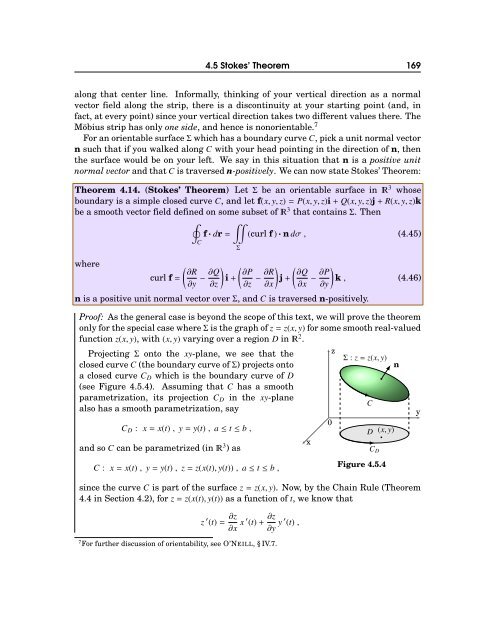Michael Corral: Vector Calculus
Michael Corral: Vector Calculus
Michael Corral: Vector Calculus
You also want an ePaper? Increase the reach of your titles
YUMPU automatically turns print PDFs into web optimized ePapers that Google loves.
4.5 Stokes’ Theorem 169<br />
along that center line. Informally, thinking of your vertical direction as a normal<br />
vector field along the strip, there is a discontinuity at your starting point (and, in<br />
fact, at every point) since your vertical direction takes two different values there. The<br />
Möbius strip has only one side, and hence is nonorientable. 7<br />
ForanorientablesurfaceΣwhichhasaboundarycurveC,pickaunitnormalvector<br />
n such that if you walked along C with your head pointing in the direction of n, then<br />
the surface would be on your left. We say in this situation that n is a positive unit<br />
normalvectorandthatC istraversedn-positively. WecannowstateStokes’Theorem:<br />
Theorem 4.14. (Stokes’ Theorem) LetΣbe an orientable surface in 3 whose<br />
boundary is a simple closed curve C, and let f(x,y,z)=P(x,y,z)i+ Q(x,y,z)j+R(x,y,z)k<br />
be a smooth vector field defined on some subset of 3 that containsΣ. Then<br />
∮ <br />
f·dr= (curl f)·ndσ, (4.45)<br />
where<br />
curl f=<br />
C<br />
Σ<br />
( ) ( ) ( ) ∂R ∂P ∂Q<br />
∂y −∂Q i+<br />
∂z ∂z −∂R j+<br />
∂x ∂x −∂P k, (4.46)<br />
∂y<br />
n is a positive unit normal vector overΣ, and C is traversed n-positively.<br />
Proof: Asthegeneral caseis beyondthescopeof thistext, wewill provethetheorem<br />
onlyforthespecialcasewhereΣisthegraphofz=z(x,y)forsomesmoothreal-valued<br />
function z(x,y), with (x,y) varying over a region D in 2 .<br />
Projecting Σ onto the xy-plane, we see that the<br />
closedcurveC (theboundarycurveofΣ)projectsonto<br />
a closed curve C D which is the boundary curve of D<br />
(see Figure 4.5.4). Assuming that C has a smooth<br />
parametrization, its projection C D in the xy-plane<br />
also has a smooth parametrization, say<br />
C D : x= x(t), y=y(t), a≤t≤b,<br />
and so C can be parametrized (in 3 ) as<br />
x<br />
0<br />
z<br />
Σ : z=z(x,y)<br />
C<br />
D<br />
C D<br />
(x,y)<br />
n<br />
y<br />
C : x= x(t), y=y(t), z=z(x(t),y(t)), a≤t≤b,<br />
Figure 4.5.4<br />
since the curve C is part of the surface z=z(x,y). Now, by the Chain Rule (Theorem<br />
4.4 in Section 4.2), for z=z(x(t),y(t)) as a function of t, we know that<br />
z ′ (t)= ∂z<br />
∂x x′ (t)+ ∂z<br />
∂y y′ (t),<br />
7 For further discussion of orientability, see O’NEILL, §IV.7.








